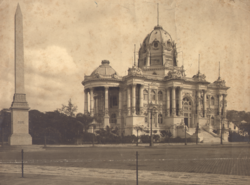Palácio_Monroe
Palácio Monroe
Former monumental hall in Rio de Janeiro, Brazil (1906–76)
The Palácio Monroe was a monumental hall in the Centro neighborhood in Rio de Janeiro, Brazil. It was named in honor of U.S. president James Monroe. It was originally built in the U.S. city of St. Louis to act as the Brazilian Pavilion during the 1904 World's Fair. Following the World's Fair, the building was dismantled and transported in cargo ships to Rio de Janeiro, where it was rebuilt in 1906. Its grand opening at the 3rd Pan-American Conference was held on July 23, 1906. From 1914 to 1920, the palace was used as the home of the Brazilian Congress. From 1925 to 1960 it was used as the home of the Brazilian Senate.
You can help expand this article with text translated from the corresponding article in Portuguese. (October 2020) Click [show] for important translation instructions.
|
In 1975, the architect and urban planner Lúcio Costa, who was the national chief of the National Institute of Historic and Artistic Heritage (Instituto do Patrimônio Histórico e Artístico Nacional – IPHAN), created a public controversy by refusing to sign the landmarking act of Palácio Monroe. The building was slated for demolition because of the construction of the Rio de Janeiro Metro, but in the face of public and media outcry, the construction company shifted the line to preserve the building. This effort, however, was in vain, because on October 11, 1975, the Brazilian president Ernesto Geisel authorized the building's demolition and a developer razed the building in March 1976. The decision was contrary to the State of Rio de Janeiro's decision declaring the building an Official Landmark in 1974.[1] In 1979, the Cinelândia Station was opened as one of the first five stations of the then-new metro network, on the site of the demolished palace.[2]

